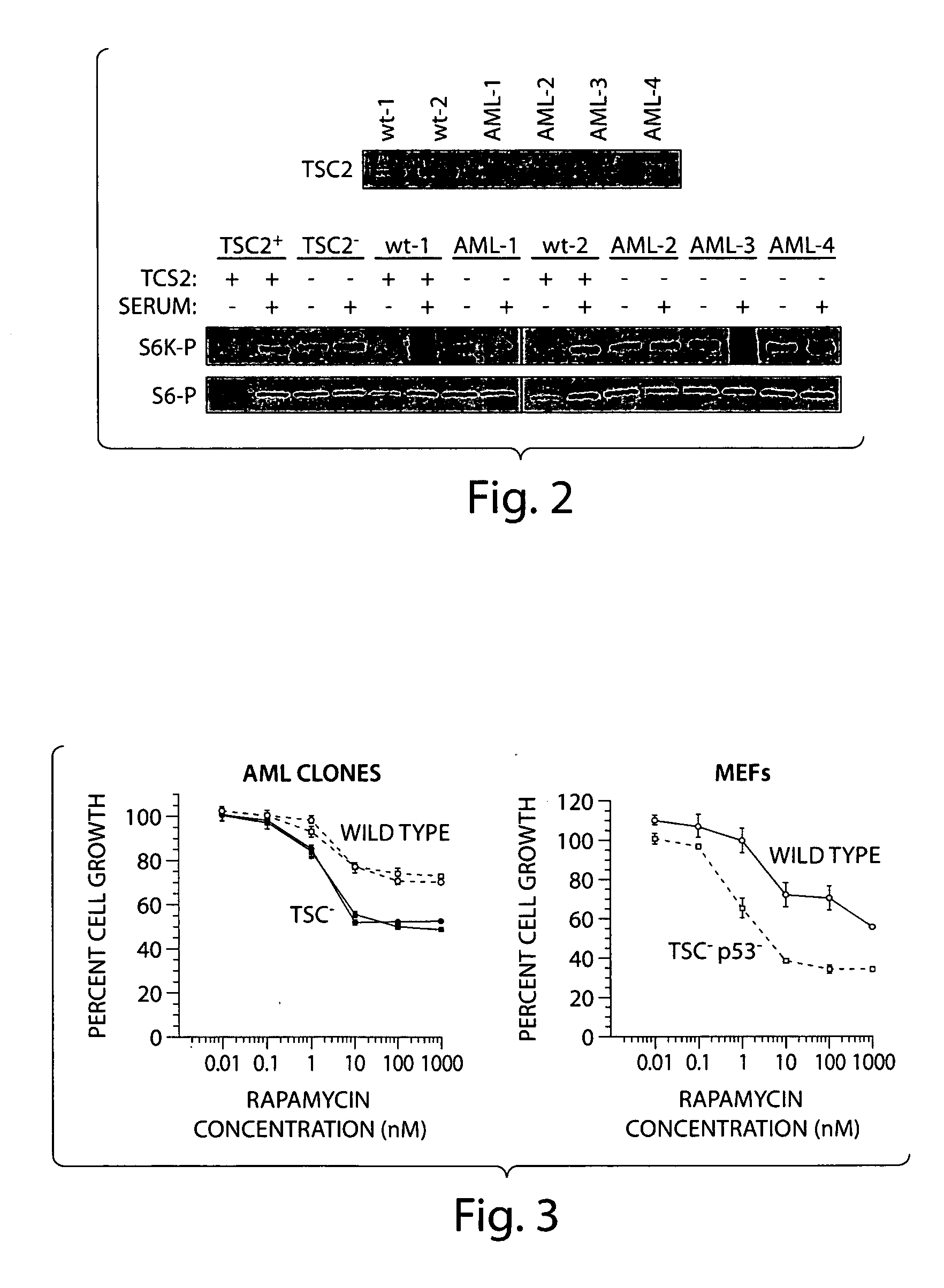Immortalized human Tuberous Sclerosis null angiomyolipoma cell and method of use thereof
a tuberous sclerosis and angiomyolipoma technology, applied in the field of new tsc/ cell lines, can solve the problems of slowing down the design of therapies against amls, progressive respiratory failure, and cystic parenchymal destruction
- Summary
- Abstract
- Description
- Claims
- Application Information
AI Technical Summary
Benefits of technology
Problems solved by technology
Method used
Image
Examples
example 1
General Methods
Cell and Tissue Acquistion
[0131] A heterogeneous population of primary AML cells obtained from a sporadic LAM patient, designated #621 was acquired from Dr. E. P. Henske (Fox Chase Cancer Research Center, Philadelphia, Pa.). AML cells within the population were determined to be TSC2-1-by genomic sequencing (Yu, J., et al. 2003). Frozen AML tissue (AML548, AML564, AML576, AML823, AML1003) and normal donor tissue (kidney, liver, lung, heart, aorta, adipose donor 1 and 2) was obtained from the Maryland Brain and Tissue Bank (Baltimore, Mass.) via IRB approved protocols. Human melanoma cell lines; Malme3M, Sk-Mel2, Sk-Mel5, Sk-Mel28, UACC62, UACC257, and M14, were obtained from the Tumor Repository of the Division of Cancer Treatment and Diagnosis, National Cancer Institute, Frederick, Mass. Melanoma cell line A375 was obtained from American Type Culture Collection (ATCC, Manassus, Va.). Amphotropic retroviral producing cell line expressing the E6E7 genes of the human ...
example 2
Generation of TSC2− / − AML Cell Lines
[0139] A heterogeneous AML tumor was obtained surgically from a sporadic LAM patient, designated patient #621. Genomic sequencing determined that the majority of cells present within the tumor possessed a missense mutation in one copy of the TSC2 gene. TSC2− / − cells within the tumor resulted from a LOH of the TSC2 gene locus. Because patient #621 has sporadic LAM and not TSC-LAM, non-AML cells within the tumor mass are TSC2+ / +. The specific point mutation is a nucleotide G to A transition at position 1832 in exon 16 of the TSC2 gene. This mutation results in the loss of a HpaII restriction endonuclease site and the creation of a fortuitous diagnostic PvuII restriction endonuclease site (FIG. 1, right panel). The AML621 mixed cell population was infected with a retrovirus carrying the E6E7 genes of the human papilloma virus. Successfully infected cells were plated at a low enough density so as to be clonally isolated by collaring. Eighty individua...
example 3
Microarray Analysis of Gene Expression in AMLS
[0143] In order to identify novel protein targets for the development of immunotherapeutics to treat TSC, microarray expression profiling was performed on 4 primary AML tumor tissues (AML548, AML564, AML576, AML1003) from different patients and TSC2− / − AML cell lines (A-A2, A-C4) to identify genes up-regulated in AMLs. AML expression data was compared to 7 pooled normal tissues, including kidney, lung, trachea, aorta, left ventricle, uterus, and whole brain. Total RNA was converted to labeled cDNA and then hybridized to the Affymetrix GeneChip Human Genome U133 2.0 plus array containing more then 38,500 genes. The heirachical clustering analysis was performed using the Spotfire DecisionSite for Functional Genomics™ software platform (Spotfire, Somerville, Mass.).
[0144] Heirarchical clustering algorithms are designed to assess how closely related multiple samples are to one another. In this case, how closely does the gene expression pro...
PUM
| Property | Measurement | Unit |
|---|---|---|
| Volume | aaaaa | aaaaa |
| Volume | aaaaa | aaaaa |
| Volume | aaaaa | aaaaa |
Abstract
Description
Claims
Application Information
 Login to View More
Login to View More - R&D
- Intellectual Property
- Life Sciences
- Materials
- Tech Scout
- Unparalleled Data Quality
- Higher Quality Content
- 60% Fewer Hallucinations
Browse by: Latest US Patents, China's latest patents, Technical Efficacy Thesaurus, Application Domain, Technology Topic, Popular Technical Reports.
© 2025 PatSnap. All rights reserved.Legal|Privacy policy|Modern Slavery Act Transparency Statement|Sitemap|About US| Contact US: help@patsnap.com



